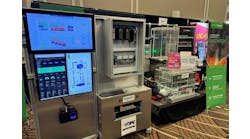Here we continue on in our exploration of what we should know but don’t know and how it hurts us.
(11) Ignoring actuator and positioner sensitivity. Piston actuators are attractive due to smaller size and lower cost but have a sensitivity that can be 10 times worse than diaphragm actuators. Many positioners look fine for conventional tests but increase response time to almost a 100 times larger for step changes in signal less than 0.2%. The result is extremely confusing erratic spikey oscillations that only get worse as you decrease the PID gain. My ISA 2017 Process Control and Safety Symposium presentation ISA-PCS-2017-Presentation-Solutions-to-Stop-Most-Oscillations.pdf show the bizarre oscillations for poor positioner sensitivity. Slides 21 through 23 show the situation, the confusion and a simple tuning fix. While the fix helps stop the oscillations, the best solution is a better valve positioner to provide precise control (critical for pH systems with a strong acid or strong base due to amplification of oscillations from sensitivity limit).
(12) Ignoring drift in thermocouples. The drift in thermocouples (TCs) can be several degrees per year. Thus, even if there is tight control, the temperature loop setpoint is wrong resulting in the wrong operating point. Since temperature loops often determine product composition and quality, the effect on process performance is considerable with the culprit largely unrecognized leading to some creative opinions. Some operators may home in on a setpoint to get them closer to the best operating point, but the next shift operator may put the setpoint back at what is defined in the operating procedures. Replacement of the thermocouple sensor means the setpoint becomes wrong. The solution is a Resistance Temperature Detector (RTD) that inherently has 2 orders of magnitude less drift and better sensitivity for temperatures less than 400 degrees C. The slightly slower response of an RTD sensor is negligible compared to the thermowell thermal lags. The only reason not to use an RTD is a huge amount of vibration or a high temperature. Please don’t say you use TCs because they are cheaper. You would be surprised at the installed cost and lifecycle cost of a TC versus an RTD. See the ISA Mentor Program Webinar “Temperature Measurement and Control” for a startling table on slide 4 comparing TCs and RTDs and a disclosure of real versus perceived reasons to use TCs on slide 7.
(13) Not realizing the effect of flow ratio on process gain. The process gain of essentially all composition, pH and temperature loops is the slope of the process variable plotted versus the ratio of the manipulated flow to the main feed flow. This means the process gain is inversely proportional to feed flow besides being proportional to slope of plot. In order to convert the slope that is the change in process variable (PV) divided by the change in ratio to the required units of the change in PV per change in manipulated flow, you have to divide by feed flow. The plot of temperature or composition versus ratio is not commonly seen or even realized as necessary. The same sort of relationship holds true where the manipulated variable is an additive or reactant flow for composition or a cooling or heating stream flow for temperature. For temperature control, the slope of the curve is often also steeper at low flow creating a double whammy as to the increase in process gain at low flow. Also, for jackets, coils and heat exchangers, the coolant flow may be lower creating more dead time for a sensor on the outlet. Fortunately for pH, we have pH titration curves where pH is plotted versus a ratio of reagent volume added to sample volume although often the sample volume added is just used on the X axis. In this case, you need to find out the sample volume so you can put the proper abscissa on the laboratory curve. In the process application the titration curve abscissa that is the ratio of reagent volume to sample volume is simply the ratio of volumetric reagent flow to volumetric feed flow if the reagent concentrations are the same. You can then use this plot with application abscissa in terms of flow ratios to determine process gain and valve capacity, rangeability, backlash (deadband) and stiction (resolution) requirements. An intelligent analysis of the amplification of oscillations by the slope of limit cycle amplitude from deadband and resolution limitations determines the number of stages and size of reagent valves needed. Often for strong acid or bases, two or three stages of neutralization with largest reagent valve on first stage and smallest reagent valve on last stage are needed due to valve rangeability or precision limitations. For more details, check out the 12/12/2015 Control Talk Blog “Hidden Factor in Our Most Important Control Loops”.
(14) Ignoring effect of temperature on actual solution pH. We are accustomed to using the built-in temperature compensator that has been in pH transmitters for 60 or more years to account for the effect of temperature seen in glass electrode Nernst Equation. What we don’t tend to do is quantify and take advantage of the solution pH compensation in smart transmitters. The dissociation constant for water, acids and bases are a function of temperature. If you express the water dissociation constant as a pKw and the acid as well as the base dissociation constant as a pka, whenever the pH is within 4 pH of the pKw or pKa, there is a significant effect of temperature on actual pH. Physical property tables can detail the pKw and pKa as a function of temperature but the best bet is to vary the temperature of a lab sample and note the change in pH after correction for the Nernst equation (some lab meters don’t do even Nernst temperature compensation).
(15) Replacing a positioner with a booster. Extensive guidelines dating back to Nyquist plot studies in the 1960s concluded that fast loops should use a booster instead of a positioner. I still hear this rule cited today. This is downright dangerous due to positive feedback from the high outlet port sensitivity of the booster and flexure of the diaphragm actuator causing valve to slam shut. The volume booster should be placed on the output of the positioner with its bypass valve slightly open to stop any high frequency oscillations as seen in the ISA Mentor Program Webinar “How to Get the Most out of Control Valves”. You can fast forward to slides 18 and 19 to see the setup.
(16) Putting VFD speed control in the DCS. We like putting controls and logic as much as possible in the control room for adjustment and maintenance. While this is normally a good idea, a speed loop in the VFD instead of DCS is orders of magnitude faster enabling much tighter control. In fact if the speed loop is put in the DCS for flow and pressure control, you will violate the cascade rule that the secondary loop (speed) must be 5 times faster than primary loop.
(17) Putting a deadband into split range block for integrating processes or cascade control or integral action in positioner. The deadband creates a limit cycle just like deadband from backlash in a control valve when there are two or more integrators in loop whether in process, PID or positioner.
(18) Not taking into account temperature and pH cross sectional profile in pipelines. The temperature and pH varies extensively across a pipeline especially for high viscosity feeds or reagents. The tip should be near the centerline. For small pipelines, this may require installing the sensor in an elbow preferably facing into flow unless too abrasive. The pH sensor tip must, of course, be pointed down preferably at about a 45 degree angle so that bubble in internal fill of electrode does not reside in tip. The angle prevents the bubble from residing at the internal electrode (relatively low probability but possible).
(19) Not preventing measurement noise from phases and mixing. Thinking we need to have the sensor see a process change as fast as possible, we fail to realize a few seconds of transportation delay is better than a poor signal to noise ratio. To prevent a sensor seeing bubbles or undissolved solids in a liquid and droplets or condensate in a gas or steam, you need to locate a sensor sufficiently downstream of static mixer or exchanger or desuperheater outlet or where any streams come together. You need to keep sensor away from a sparge and avoid top or bottom of vessel or horizontal line. For temperature control of a jacketed vessel with split ranged manipulation of cooling water and steam, you should use jacket outlet instead of inlet temperature measurement to allow time for water to vaporize and for steam to condense. An even better solution is to use a steam injector to heat up the cooling water eliminating the transition of phases from going back and forth between steam and cooling water in the jacket. The injector provides rapid and smooth transitions from cooling to heating over quite a temperature range going from cold to hot water.
(20) Tuning to make smooth approach of PID output to final resting value in near and true integrating chemical processes. The main task of composition, temperature and pH loops in chemical processes is to be able to effectively reject load disturbances at the process input. This requires a maximization of controller gain and significant overshoot by the controller output of the final resting value to balance the load. Many experts in tuning who worked mostly on self-regulating processes don’t realize this requirement and may even say you should never tune the controller output to overshoot the final resting value failing to realize near-integrating processes will take an incredible long time to recover and true integrating processes will never recover from load disturbance. To understand the necessity of overshoot in PID output, think of a level loop where the level has increased because the flow into the vessel has increased. To bring the level back down to setpoint, the outlet flow manipulated by the level controller must be greater than the inlet flow to lower the level to setpoint before outlet flow settles out to match the inlet flow (final resting value of PID output).
Always remember to …………………………………………………………..………….. Oh shoot, I forget ... senior moment.




